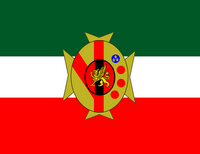Tuscany

| |

| |
| Cities: | |
| Capital: | Florence |
| Largest: | Florence |
| Other: | Siena Livorno Pisa |
| Languages: | |
| Official: | Italian Tuscan |
| Others: | Elbic Carrarrese Corsican |
| Grand Duke: | Leopold III |
| Prime Minister: | Saverio Fiori |
| Area: | ... |
| Population: | 3,446,009 Tuscanese |
| Established: | 1569, Declared by the Medici family when they took control of the Republic of Florence |
The Grand Duchy of Tuscany is a state in central Italy which came into existence in 1569, replacing the Duchy of Florence, which had been created out of the old Republic of Florence in 1532, and which annexed the Republic of Siena in 1557.
Administration
Government
In theory Tuscany's head of state is the Grand Duke, but in practice this is all but ignored in the day-to-day operations of the government. The Grand Duke and his family have no official functions, no duties, no special privileges save social ones.
Each province elects three members to the Consiglio dei ministri (Cabinet) which serves as both Cabinet and legislature for Tuscany (a total of 33 Ministri. These members serve for six years each, but one third are subject to reelection each two years. The Presidente del consiglio dei ministri (President of the Council of Ministers, or Prime Minister) is elected for one five year term in a general election. The Presidente may not serve two consecutive terms. Tuscany has an independent judiciary, headed by the Corte Costituzionale.
All citizens above the age of twenty are permitted to vote. Politically, the Christian Democrats (a left-of-center party) tends to hold office, but communist, ecotopic and socialist parties are also prevalent. A small neocapitalist party also exists. The Ducal Restoration Party is allied with the League of Noble Emigrees but has virtually no political power.
The Grand Duke
Leopold III (born 1975) is the fourth Duke of the House of Habsburg-Bailbiret. He is one of six children of the former Duke, Cosimo II (1928-1997) and the only male. A gifted attorney, he is among considered one of the most eligible bachelors in Europe.
Administrative Divisions
Tuscany is divided into eight smaller provinces, each named for the city that they are centered on.
- Arezzo
- Firenze
- Grosseto
- Livorno
- Pisa
- Pistoia
- Prato
- Siena
History
See main article: History of Tuscany.
Geography
Borders
Tuscany is bordered by:
North: Massa, Modena, Romagna
West: Tyrrhenian Sea, Elba, Piombino
South: Papal States
East: Umbria, the Marches
Economy
Pisa and Florence both have international aerodromes. Among other things, this is very helpful to the tourist industry (which is a major reason the government retains the ducal arms for the flag and makes no move to strip the Grand Dukes of their property or perks--because the Grand Dukes are considered assets to tourism). Tuscany is known for its wines (most famous of which are Chianti, Morellino di Scansano and Brunello di Montalcino).
Culture
Tuscany is overwhelmingly Latin-Rite Roman Catholic.
A local dialect, Tuscan, basis of the current Italian language, is widely spoken, especially in the rural zones. It features however several distinctions from Italian, such as the weakening of letters "G", "C", "T" and "P", the strong usage of the impersonal form si, and a slightly different lexicon (e.g. babbo instead of padre and garbare instead of piacere).
Tuscany was essentially the birthplace of the Italian Renaissance, and its artistic heritage includes architecture, painting and sculpture, collected in dozens of museums, the best-known of which is the Uffizi in Florence and in situ in even quite small cities.
| |||
|---|---|---|---|
| Member Entities | |||
| Aosta | Ceva | Elba | Friuli | Liguria | Lombardy | Mantova | Marches | Massa | Metropolitan Duchies | Montferrat | Modena | Novellara | Parma | Piedmont | Piombino | Romagna | Trento | Tuscany | Umbria | Veneto |